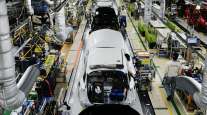Longshoremen’s Union Pledges to Fight Port Automation as Execs Call it Inevitable

The head of the International Longshoremen’s Association plans to fight efforts to automate terminals as part of the negotiations beginning in February on a new contract to cover 65,000 dockworkers. However, a panelist at the 2017 Transportation Research Board conference described it as inevitable.
“The ILA will not allow automation to rip apart our livelihoods and destroy our jobs and families. Right from the outset, the ILA intends to let management know that we are totally opposed to fully automated terminals,” wrote ILA president Harold Daggett in a Jan. 5 message to members.
RELATED: Robots could replace 1.7 million American truckers in the next decade
He added, “Fully automated terminals spell the end of longshoring jobs, no questions asked. The ILA has no problem with semi-automated terminals —we know that we cannot stop progress and many forms of new technology help our workers do their jobs more efficiently, more safely, but without the threat of job elimination.”
Bethann Rooney, assistant director of port performance initiatives at the Port of New York and New Jersey, called the comments “concerning” because the United States is “behind the eight ball” on terminal automation compared with Asia and Europe. She reacted to the comments during a discussion on megaships at the Transportation Research Board conference on Jan. 8.
“I understand what Harold is doing and saying but technology is changing the work and the jobs and the employment in many fields and we’re just one of them,” she said at the industry conference. “The question is how can we use and adapt technology to help our industry be more efficient, reliable and predictable, yet still keep folks gainfully employed. It’s a careful dance that still needs to be worked out.”
She likened the current situation to smartphones that took decades to develop from the beginnings of the computer industry but now has evolved so rapidly that most Americans own one.
“What we need to be thinking about is how is that workforce going to change and how do we ensure that we have a properly trained, rightsized, ready workforce to handle the changing needs of the industry,” Rooney said.




